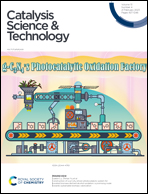Ambient sunlight-driven high performance chlorinated volatile organic compound oxidation by Cu0.15Mn0.15Ce0.7Ox hollow spheres†
Abstract
The catalytic oxidation of chlorinated volatile organic compounds (CVOCs) faces the stringent constraint of high reaction temperature for large-scale applications. In this work, hollow spherical Cu0.15Mn0.15Ce0.7Ox was synthesized using the carbon sphere template method, and Cu0.15Mn0.15Ce0.7Ox decreased the T100 of chlorobenzene (CB) by 55 °C compared to the bulk Cu0.15Mn0.15Ce0.7Ox without the template. Furthermore, the regular spherical structure of Cu0.15Mn0.15Ce0.7Ox endowed it with a larger surface area, more Mn4+, and richer oxygen vacancies. These combined merits triggered more active oxygen species, better redox property, and improved adsorption capacity, ultimately resulting in the superior activity of Cu0.15Mn0.15Ce0.7Ox. Furthermore, an elaborate photothermal device was used to drive catalysis by sunlight. Cu0.15Mn0.15Ce0.7Ox could be heated to 300.8 °C under one standard sunlight and achieved a CB conversion rate of 3.5 mmol g−1 h−1. This catalytic oxidation system maintained complete degradation with robust stability for 48 h. These findings reveal the synergistic combination of ternary metal oxides and ambient sunlight-driven catalysis for the efficient degradation of CVOCs.



 Please wait while we load your content...
Please wait while we load your content...